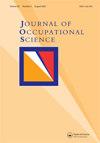“Doing together”: Mothers use co-occupation to scaffold the occupational engagement of their children with fetal alcohol spectrum disorder
IF 2.4
Q1 SOCIAL SCIENCES, INTERDISCIPLINARY
引用次数: 1
Abstract
ABSTRACT South Africa has the highest reported prevalence of fetal alcohol spectrum disorder (FASD) worldwide. This paper describes the contribution mothers make to engage their children with FASD in occupations through ‘doing together’. It draws on the findings of a qualitative descriptive study to provide an understanding of the diverse ways in which mothers used co-occupation to facilitate the occupational engagement of their children with FASD. Nine mothers were purposively and incrementally sampled in line with the sampling principle of maximum variation. Semi-structured and photo elicitation interviews (PEI) were used to gain descriptions of the ways that mothers scaffolded their children’s participation during occupations they did together. Data were transcribed verbatim and inductively analysed. The theme ‘Doing together’ captured the primary way in which mothers fostered opportunities for their children to engage in and develop their participation in occupations. Nested in the theme were five categories, each describing particular ways of scaffolding during co-occupation: casual inclusion, flexible expectations, grading support, maximising opportunities and involving others. The findings revealed that mothers continued to invest in fostering occupational engagement, even when their children became adults. The specific scaffolding strategies these mothers used are discussed in relation to occupational scaffolding and co-occupation literature, highlighting the dynamics of person-context relations in an underdeveloped rural community. Study findings reveal mothers expertise in supporting the development of their children as occupational beings.“一起做”:母亲们利用共同职业来为患有胎儿酒精谱系障碍的孩子提供职业参与
摘要:南非是世界上报告的胎儿酒精谱系障碍(FASD)患病率最高的国家。本文描述了母亲通过“一起做”让患有FASD的孩子从事职业所做的贡献。它借鉴了一项定性描述性研究的结果,以了解母亲使用共同职业促进子女参与FASD的各种方式。根据最大变异的抽样原则,对9名母亲进行了有针对性的增量抽样。半结构化和照片启发访谈(PEI)被用来描述母亲们在一起工作时如何让孩子参与进来。数据被逐字转录并归纳分析。“一起做”主题体现了母亲为孩子创造参与和发展职业参与机会的主要方式。主题中嵌套了五个类别,每个类别都描述了共同职业期间搭建脚手架的特殊方式:随意包容、灵活期望、分级支持、最大限度地增加机会和让他人参与。研究结果显示,即使孩子长大成人,母亲们仍在继续投资促进职业参与。这些母亲使用的具体支架策略与职业支架和共同职业文献有关,强调了欠发达农村社区中人与环境关系的动态。研究结果揭示了母亲在支持子女职业发展方面的专业知识。
本文章由计算机程序翻译,如有差异,请以英文原文为准。
求助全文
约1分钟内获得全文
求助全文
来源期刊

Journal of Occupational Science
SOCIAL SCIENCES, INTERDISCIPLINARY-
CiteScore
4.30
自引率
41.70%
发文量
46
 求助内容:
求助内容: 应助结果提醒方式:
应助结果提醒方式:


